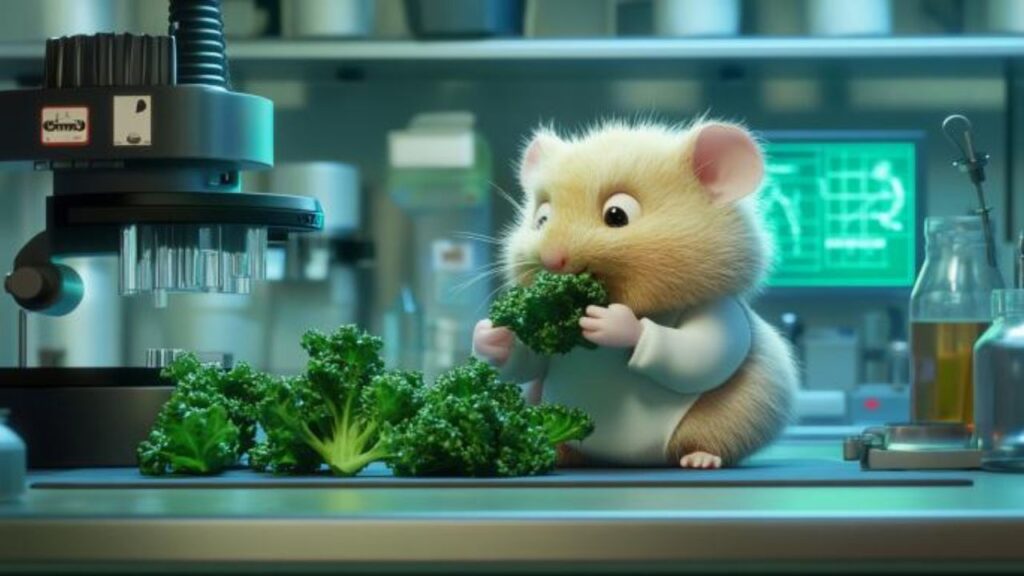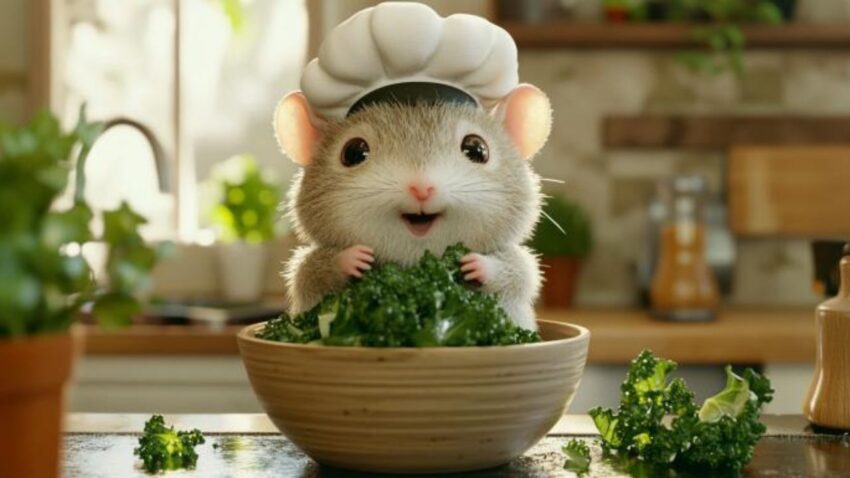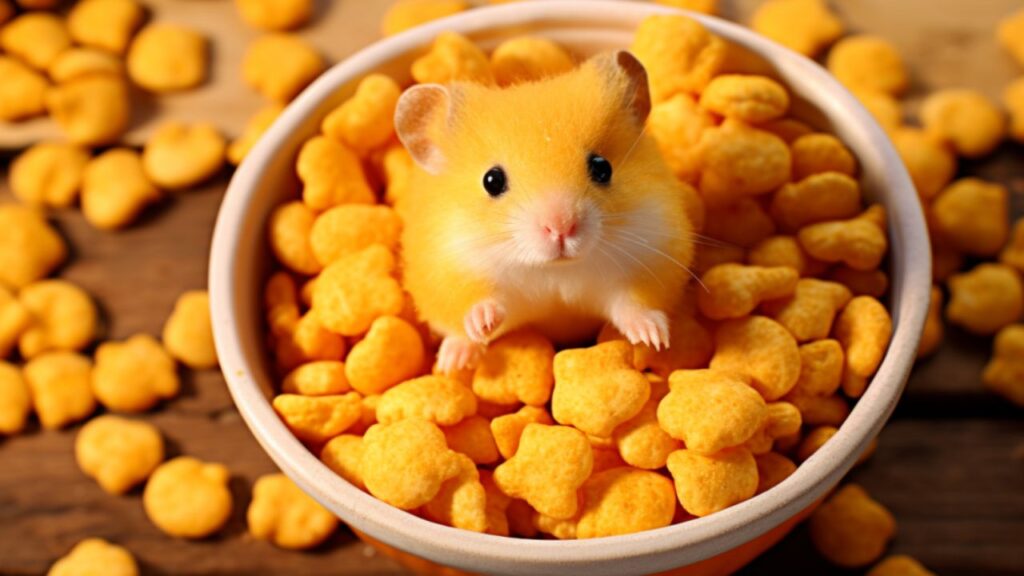TL;DR Summary
Yes, hamsters can eat kale, but only in moderation. Kale is rich in vitamins and minerals beneficial for hamsters, such as Vitamin C and calcium. However, it contains oxalates and goitrogens, which can pose health risks if consumed excessively. Offer small, washed pieces no more than once or twice a week as part of a varied diet. Always monitor for any adverse reactions.
Kale has gained a reputation as a superfood, celebrated for its dense nutritional profile and numerous health benefits for humans. Rich in vitamins, minerals, and antioxidants, this leafy green has become a staple in many health-conscious diets. However, as hamster owners, it’s natural to wonder whether this nutrient-packed vegetable is also suitable for our tiny, furry friends. Can hamsters eat kale, and if so, how much is safe?
Just like humans, hamsters require a balanced diet to maintain optimal health and vitality. Their dietary needs are distinct, focusing on a mix of high-quality pellets, seeds, grains, and a selection of fresh vegetables and occasional fruits. Introducing new foods to a hamster’s diet should always be done with caution, as their small size and sensitive digestive systems can make them more susceptible to dietary imbalances.
In this comprehensive guide, we’ll explore the potential benefits and risks of feeding kale to hamsters. We’ll dive into the nutritional aspects of kale, discuss its safety, and provide practical tips for safely incorporating it into your hamster’s diet. By the end of this article, you’ll have a clear understanding of how kale fits into a balanced diet for hamsters, ensuring your pet stays happy and healthy.
Nutritional Profile of Kale

Kale is often heralded as a superfood due to its impressive array of vitamins, minerals, and other essential nutrients. This dark leafy green is not only beneficial for humans but can also offer valuable nutrients to hamsters when included in their diet appropriately. Let’s delve into the nutritional components of kale and how they can contribute to the health and well-being of your hamster.
Vitamins in Kale
- Vitamin C: Kale is an excellent source of Vitamin C, an antioxidant crucial for preventing scurvy, a disease caused by Vitamin C deficiency. Although hamsters can synthesize their own Vitamin C, providing them with a diet rich in this vitamin helps support their immune system, skin health, and overall vitality.
- Vitamin K: This vitamin plays a vital role in blood clotting and bone health. Kale’s high Vitamin K content can aid in maintaining strong bones and proper blood clotting mechanisms in hamsters, which is particularly beneficial given their active nature and potential for injuries.
- Vitamin A: Essential for vision, growth, and immune function, Vitamin A is abundant in kale. For hamsters, Vitamin A supports healthy eyesight, skin health, and overall immune system efficiency, helping them to fend off infections and maintain good health.
Minerals in Kale
- Calcium: Calcium is crucial for bone and teeth health in hamsters. Kale provides a good amount of calcium, which helps in maintaining strong bones and teeth. However, it’s important to monitor calcium intake, as excessive calcium can lead to bladder stones or other health issues in hamsters.
- Iron: Iron is necessary for the production of hemoglobin, the protein in red blood cells that carries oxygen throughout the body. Kale’s iron content supports this essential function, helping to prevent anemia and ensuring that hamsters remain energetic and active.
- Potassium: This mineral is important for regulating fluid balance, muscle contractions, and nerve signals. The potassium in kale can help maintain a hamster’s overall metabolic functions, supporting heart health and muscle coordination.
Other Nutrients and Benefits
- Fiber: Kale is rich in dietary fiber, which aids in digestion. For hamsters, fiber can help prevent constipation and promote a healthy digestive system. However, too much fiber can cause digestive upset, so it’s crucial to balance kale with other foods in the diet.
- Antioxidants: Kale contains various antioxidants, including flavonoids and carotenoids, which help combat oxidative stress. These antioxidants can reduce the risk of chronic diseases and support a healthy immune system in hamsters.
- Omega-3 Fatty Acids: Although present in small amounts, the omega-3 fatty acids in kale contribute to a healthy heart and brain function. These beneficial fats can help support the overall health of your hamster, contributing to a shiny coat and healthy skin.
Potential Health Benefits for Hamsters
Incorporating kale into your hamster’s diet can offer several health benefits, thanks to its rich nutritional profile. The vitamins and minerals found in kale can support various aspects of a hamster’s health, including:
- Immune Support: The antioxidants and vitamins, particularly Vitamin C, help boost the immune system, making hamsters less susceptible to illnesses.
- Bone and Teeth Health: The calcium and Vitamin K in kale contribute to strong bones and teeth, which are vital for a hamster’s well-being, especially given their constant chewing and gnawing habits.
- Digestive Health: The fiber content in kale aids in digestion, helping to regulate bowel movements and prevent constipation.
- Overall Well-being: The combination of essential nutrients supports the overall health and vitality of hamsters, promoting a shiny coat, healthy skin, and a robust constitution.
While kale can be a valuable addition to a hamster’s diet, it should be fed in moderation due to its high calcium content and potential goitrogens, which can interfere with thyroid function if consumed in excess. Always ensure that kale is just one part of a varied and balanced diet for your hamster, including other vegetables, seeds, and specially formulated hamster food.
By understanding the nutritional profile of kale and its benefits, you can make informed decisions about how to safely incorporate this leafy green into your hamster’s diet, ensuring they enjoy the benefits without any adverse effects.
Is Kale Safe for Hamsters?

Kale, with its impressive nutritional profile, may seem like an ideal addition to a hamster’s diet. However, it’s essential to evaluate the safety of this leafy green for our small pets. While kale can offer numerous benefits, it also contains certain compounds that require cautious feeding. This section will analyze the safety of kale for hamsters, highlighting potential risks such as oxalates and goitrogens, and compare it to other leafy greens that are safe for hamsters.
The Safety Concerns: Oxalates and Goitrogens
- Oxalates: Kale contains oxalates, naturally occurring compounds found in many plants. In high quantities, oxalates can bind with calcium in the digestive tract, potentially leading to the formation of calcium oxalate stones, commonly known as kidney or bladder stones. For hamsters, who have small and sensitive digestive systems, the risk is particularly notable if kale is consumed excessively.
- Managing Oxalate Risks: While the presence of oxalates doesn’t mean kale is inherently unsafe, it does suggest that moderation is crucial. Offering kale as a small, occasional treat rather than a staple can help minimize the risk of stone formation. Additionally, providing a balanced diet with a variety of vegetables can help dilute the oxalate intake.
- Goitrogens: Kale, like other cruciferous vegetables, contains goitrogens—compounds that can interfere with thyroid function by inhibiting iodine uptake. This can potentially lead to goiter, an enlargement of the thyroid gland, and other thyroid-related issues if consumed in large quantities.
- Minimizing Goitrogen Exposure: The goitrogenic effect of kale is generally only a concern with excessive intake. For hamsters, this means kale should be offered sparingly, ensuring it doesn’t become a significant portion of their diet. As with oxalates, balancing kale with other non-cruciferous vegetables can help mitigate potential risks.
Comparison to Other Leafy Greens
To better understand the place of kale in a hamster’s diet, it’s useful to compare it with other leafy greens commonly fed to hamsters. Each has its unique benefits and considerations:
- Spinach: Like kale, spinach is rich in vitamins A and C and also contains oxalates. However, spinach tends to have higher oxalate levels than kale, making it necessary to feed in even smaller amounts.
- Romaine Lettuce: A safe and popular choice, romaine lettuce is low in oxalates and goitrogens. It provides hydration and some fiber without the same risks associated with kale and spinach. However, it should be offered fresh and in moderation to avoid digestive upset.
- Dandelion Greens: These are a nutritious option, providing vitamins A and C, calcium, and antioxidants. They are lower in oxalates compared to kale and spinach, making them a safer choice for more regular feeding. However, it’s essential to ensure they are pesticide-free and collected from safe areas if not store-bought.
- Parsley: While parsley is a nutritious herb, it’s also rich in oxalates and should be fed sparingly. It can provide a tasty, aromatic addition to a hamster’s diet but should be balanced with other greens.
Safe Feeding Practices
To safely incorporate kale into your hamster’s diet, consider the following tips:
- Moderation is Key: Offer kale in small amounts, perhaps once or twice a week, as part of a varied diet that includes other safe vegetables. A leaf or two is generally sufficient, depending on the size of your hamster.
- Balance with Other Vegetables: To minimize the risks associated with oxalates and goitrogens, balance kale with other low-risk vegetables like romaine lettuce or dandelion greens. This variety ensures a broad spectrum of nutrients without overloading on any potentially harmful compounds.
- Preparation: Always wash kale thoroughly to remove any pesticides or dirt. Opt for organic if possible, to reduce exposure to harmful chemicals. Chopping the kale into small, manageable pieces makes it easier for your hamster to eat and digest.
How Much Kale Should Hamsters Eat?

Feeding kale to hamsters can be a beneficial addition to their diet, but it’s crucial to get the portion sizes and frequency right to avoid potential health risks. The key to incorporating kale safely into a hamster’s diet lies in moderation and ensuring a balanced diet with a variety of foods.
Recommended Portion Sizes
Given the small size of hamsters and their specific dietary needs, it’s important to offer kale in very controlled amounts. A safe portion size for kale is roughly the size of a coin—a small leaf or a few small, chopped pieces. For dwarf hamsters, which are even smaller and more sensitive to dietary changes, the portion should be reduced to just a few tiny pieces, equivalent to about half the size of a fingernail.
Kale should be thoroughly washed to remove any pesticide residues and chopped into small, manageable pieces. This preparation not only helps your hamster eat the kale more easily but also prevents any potential choking hazards. It’s also best to serve kale fresh; wilted or spoiled greens can upset a hamster’s delicate digestive system.
Frequency of Feeding
Kale should not be a daily component of a hamster’s diet due to its high levels of oxalates and goitrogens, which can cause health issues if consumed excessively. A good rule of thumb is to offer kale no more than once or twice a week. This frequency ensures that your hamster can benefit from the nutrients in kale, like Vitamin C, Vitamin K, and calcium, without the risks associated with overconsumption.
Importance of Variety in a Hamster’s Diet
While kale can be a nutritious treat, it should not be the sole or primary vegetable in a hamster’s diet. A varied diet is essential for hamsters, providing them with a broad spectrum of nutrients and preventing dietary deficiencies. Including a mix of different vegetables ensures that your hamster receives all the necessary vitamins and minerals for optimal health.
Here are some other vegetables that can be safely included in your hamster’s diet alongside kale:
- Romaine Lettuce: Low in calories and oxalates, romaine lettuce is a hydrating and safe choice.
- Carrot: A sweet and crunchy treat, carrots are rich in beta-carotene and provide a good source of fiber.
- Cucumber: High in water content, cucumbers help with hydration and are gentle on the stomach.
- Bell Pepper: Packed with Vitamin C and antioxidants, bell peppers are a colorful and nutritious addition.
- Broccoli: Another cruciferous vegetable, broccoli should also be fed in moderation due to its goitrogen content, but it is rich in fiber and Vitamin C.
By rotating these vegetables, you can ensure that your hamster enjoys a well-rounded diet. This variety not only provides a range of nutrients but also keeps mealtime interesting for your hamster, promoting a healthy appetite and good eating habits.
Balancing Nutrient Intake
While kale provides several beneficial nutrients, balancing its intake with other vegetables helps mitigate the risks associated with high oxalate and goitrogen levels. For example, too much calcium from kale and other high-calcium vegetables can contribute to bladder stones, a condition that can be painful and potentially serious for hamsters. Therefore, balance is key, both in terms of the types of vegetables offered and the overall diet.
In addition to vegetables, ensure your hamster’s diet includes high-quality hamster pellets, which provide essential proteins, fats, and carbohydrates. Fresh water should always be available, and occasional fruits can be given as treats, though these should be limited due to their high sugar content.
Monitoring and Adjusting Diet
Always monitor your hamster’s response to new foods, including kale. Watch for signs of digestive distress, such as diarrhea or bloating, and adjust the diet accordingly if any adverse reactions occur. It’s also important to observe your hamster’s overall health and behavior, as changes in diet can sometimes reveal underlying health issues.
Preparation and Serving Tips for Kale

Properly preparing kale for your hamster is essential to ensure they can safely enjoy this nutritious leafy green. The process involves several crucial steps, from selecting the right kale to washing, chopping, and serving it in appropriate portions. Here’s a detailed guide on how to prepare kale for your hamster, along with important considerations to keep in mind.
Selecting the Right Kale
When choosing kale for your hamster, opt for fresh, organic kale whenever possible. Organic kale is less likely to contain harmful pesticides and chemicals that could negatively impact your hamster’s health. Look for kale that is vibrant green in color, with firm leaves and no signs of wilting or yellowing, as these indicate freshness and nutrient density.
Washing the Kale
Washing kale thoroughly is a vital step in preparing it for your hamster. Even organic kale can have traces of dirt, insects, or natural residues that should be removed before feeding. Here’s how to wash kale properly:
- Rinse Under Cold Water: Hold the kale under cold running water. Gently rub the leaves with your fingers to remove any dirt or debris. Pay special attention to the undersides of the leaves where dirt and small insects can hide.
- Soak in a Vinegar Solution (Optional): For an extra layer of cleanliness, you can soak the kale in a solution of water and vinegar (one part vinegar to three parts water) for a few minutes. This can help remove more stubborn pesticide residues. After soaking, rinse the kale thoroughly under cold water to remove any vinegar residue.
- Drying the Kale: Shake off excess water and pat the leaves dry with a clean towel or use a salad spinner. Ensuring the kale is dry helps prevent bacterial growth, which can occur on wet leaves.
Chopping the Kale
After washing and drying, the next step is to chop the kale into manageable pieces. This not only makes it easier for your hamster to eat but also helps prevent choking hazards.
- Remove the Stems: The stems of kale can be tough and fibrous, making them difficult for hamsters to chew and digest. Remove the central stems and only use the tender parts of the leaves.
- Cut into Small Pieces: Chop the kale leaves into small pieces, roughly the size of your hamster’s paw or even smaller for dwarf hamsters. This size is easy for them to handle and reduces the risk of choking or overeating.
Serving Fresh and Pesticide-Free Kale
Serving fresh kale is crucial for your hamster’s health. Fresh kale provides the maximum nutritional benefit and is more palatable for your hamster. Always check the kale for freshness before serving. Avoid serving wilted, yellowing, or spoiled leaves, as these can cause digestive issues and are less nutritious.
- Pesticide-Free Kale: If you cannot find organic kale, thoroughly washing the kale, as described above, is even more critical to remove any pesticide residues. Pesticides can be harmful to hamsters, potentially leading to health issues such as digestive upset or long-term organ damage.
Portion Control and Serving Frequency
As discussed in previous sections, portion control is vital when feeding kale to hamsters. A small piece, about the size of a coin, is sufficient for Syrian hamsters, while dwarf hamsters should receive an even smaller portion. Serve kale no more than once or twice a week to prevent issues related to oxalates and goitrogens, which can affect calcium absorption and thyroid function if consumed in excess.
Storing Leftover Kale
If you have leftover kale, store it properly to maintain its freshness. Place the unused kale in an airtight container or a resealable plastic bag, and keep it in the refrigerator. Use the stored kale within a few days to ensure it remains fresh and safe for your hamster.
Monitoring and Cleanup
After serving kale, observe your hamster for any signs of digestive upset, such as diarrhea or lethargy. If such symptoms occur, remove kale from their diet and consult a veterinarian if symptoms persist. Always remove any uneaten kale from your hamster’s cage after a few hours to prevent spoilage, which can attract pests and promote bacterial growth.
Whisker Tips: Practical Advice for Feeding Kale to Your Hamster

Feeding kale to your hamster can be a delightful way to add nutritional variety to their diet, but it’s important to do so safely and thoughtfully. Here are some practical tips to help you incorporate kale into your hamster’s meals, along with suggestions for other vegetables that can complement kale, ensuring a balanced and healthy diet.
Introduce Kale Gradually
When introducing kale to your hamster’s diet, start with a very small amount. This helps your hamster adjust to the new food and allows you to monitor for any adverse reactions, such as digestive upset or changes in behavior. Begin with a piece about the size of a fingernail, and if your hamster tolerates it well, you can gradually increase the portion size to a small leaf or a few tiny pieces.
Rotate Vegetables for Variety
While kale is nutritious, it’s important to offer a variety of vegetables to ensure a well-rounded diet. Different vegetables provide different vitamins, minerals, and antioxidants, which together contribute to your hamster’s overall health. Here are some other vegetables that can be safely included in your hamster’s diet:
- Romaine Lettuce: Low in calories and oxalates, romaine lettuce is a great hydrating option. It’s also less likely to cause digestive issues compared to other lettuces.
- Carrots: Rich in beta-carotene, carrots are a crunchy, sweet treat that hamsters often love. They should be given in moderation due to their natural sugar content.
- Cucumbers: High in water content, cucumbers are perfect for keeping your hamster hydrated. They are gentle on the digestive system and can be served in small slices.
- Bell Peppers: Packed with Vitamin C and other antioxidants, bell peppers add color and variety to your hamster’s diet. They are best served raw and chopped into small pieces.
- Broccoli: Although also a cruciferous vegetable like kale, broccoli is a good source of fiber and Vitamin C. Feed it in moderation due to its goitrogen content.
- Zucchini: This soft and mild vegetable is easy for hamsters to eat and digest. Zucchini can be served raw and is a great way to add moisture to your hamster’s diet.
Monitor Your Hamster’s Reaction
Always observe your hamster after introducing kale or any new food. Watch for signs of discomfort, such as bloating, diarrhea, or changes in behavior. If your hamster shows any negative symptoms, remove kale from their diet and consult a veterinarian if symptoms persist. Monitoring your hamster’s health will help you adjust their diet as needed and ensure they remain healthy and happy.
Maintain Proper Hygiene
Hygiene is crucial when preparing and serving kale to your hamster. Always wash kale thoroughly to remove any pesticides, dirt, or insects. Use organic kale whenever possible to reduce the risk of harmful chemicals. Also, ensure that all serving utensils and food dishes are clean to prevent bacterial contamination.
Portion Control and Frequency
Remember that moderation is key when feeding kale to your hamster. A small portion once or twice a week is sufficient. Overfeeding can lead to health issues such as kidney stones or thyroid problems due to the oxalates and goitrogens present in kale. By keeping portions small and infrequent, you can enjoy the benefits of kale without the risks.
Store Leftover Kale Properly
If you have leftover kale, store it in an airtight container or resealable bag in the refrigerator. Use the leftovers within a few days to ensure they remain fresh and nutritious. Never feed your hamster kale that has become wilted or spoiled, as this can cause digestive issues.
Keep a Food Diary
Consider keeping a food diary for your hamster, noting down what they eat and any reactions they have. This can be particularly useful if you’re introducing new foods like kale, as it helps track what works well and what doesn’t. A food diary can also be a valuable tool if you need to consult a veterinarian about dietary issues or health concerns.
Enrichment and Interaction
Feeding your hamster kale can also be an opportunity for enrichment and bonding. Offer kale leaves by hand to encourage interaction and trust-building. You can also hide small pieces of kale in their habitat to stimulate foraging behavior, which is both mentally and physically beneficial for hamsters.
Conclusion

Kale is a nutrient-dense leafy green that can offer several health benefits to hamsters, including essential vitamins like Vitamin C and Vitamin K, minerals such as calcium and iron, and a good amount of dietary fiber. These nutrients can support a hamster’s immune system, bone health, and overall vitality. However, it’s crucial to approach feeding kale with caution due to its content of oxalates and goitrogens, which can pose health risks if consumed in excess.
To safely incorporate kale into your hamster’s diet, it is recommended to start with small portions—about the size of a fingernail for dwarf hamsters and a small leaf for larger breeds like Syrian hamsters. Limit kale to once or twice a week to avoid overexposure to oxalates and goitrogens, and always serve it as part of a varied diet that includes other safe vegetables like romaine lettuce, carrots, cucumbers, bell peppers, broccoli, and zucchini.
Proper preparation is key: always wash kale thoroughly to remove any pesticide residues and chop it into small, manageable pieces. This ensures that your hamster can safely consume the kale without any risk of choking or digestive discomfort. Storing leftover kale properly and monitoring your hamster’s reaction to new foods are also important steps in maintaining their health and happiness.
By balancing kale with a range of other vegetables and monitoring portion sizes and frequency, you can provide a well-rounded diet that supports your hamster’s overall well-being. This thoughtful approach not only enhances their nutrition but also offers enrichment and variety, making mealtime an exciting experience for your furry friend.
In summary, kale can be a beneficial addition to a hamster’s diet when offered in moderation and with proper precautions. It’s all about striking the right balance and ensuring that your hamster enjoys a diverse and healthy diet.
Remember, a happy hamster is a wheel-y happy you!




